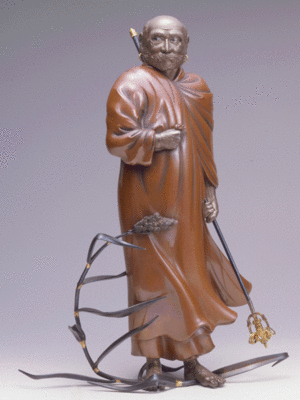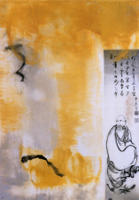:::::::::::::::::::::::::::::::::::::::::::::::::::::::::::::::::::::::::::::::::::::::::::::::::::::
Daruma on a Rush-Leaf . . on a reed
Royoo Daruma 芦葉達磨
There are many renderings of Daruma figures, but what they want to express on the inside is always the same. It is the spirit of Daruma Daishi (about 5th Cent.), the eighth generation Great Master after Shakyamuni Buddha, founder of the Zen sect. Legend says that Daruma was born the third prince in a South Indian kingdom. He was of a sharp mind already as a child and followed the Great Master Prajnaatara, where he studied Buddhism intensly and carried on his tradition. He then took off to China to preach Buddhism, taking the sea road to South China.
He was invited by Emperor Wu and expounded his wisdom for him. But the emperor did not understand the preachings of Daruma, so Daruma took off again, crossing the Yangtse River to the east and ended up in the Shaolin Temple near Loyang. He stood on some reeds when crossing the river, which leads to the famous iconographic rendering of "Rush-leaf Daruma" (royoo Daruma 芦葉達磨).
:::::::::::::::::::::::::::::::::::::::::::::::::::::::::::::::::::::::::::::::::::::::::::::::::::::

正阿弥勝義作 芦葉達磨像
©(林原美術館蔵)
by Shooami Katsuyoshi
http://www.libnet.pref.okayama.jp/mmhp/kyodo/person/syouami/syouami.htm
Shooami was born in Tsuyama, a city close to my present home in Japan.
:::::::::::::::::::::::::::::::::::::::::::::::::::::::::::::::::::::::::::::::::::::::::::::::::::::
Nantembo (1839-1925)
Daruma crossing the Yangzi river on a rush leaf

..... Although the emperor was gracious, he did not pretend to grasp Bodhidharma's meaning, and the monk decided to travel north, crossing the Yangtze River on a rush leaf (J. royô) and went to the northern kingdom of Wei where he spent nine years meditating in the Shaolin monastery.
Bodhidharma's mysterious crossing the Yangzi River on a rush leaf has first been mentioned in the 13th century: The Wudeng huiyuan, edited in 1252 by Dachuan Puji (1179-1253), the Wujia zhangzong zan, compiled two years later by Xisou Shaotan (d. 1279) and the Shishi tongjian, in 1270 by Ben Jue state Bodhidharma's breaking off a rush leaf and crossing the Yangzi river. But these sources do not indicate the use of the rush leaf as a vehicle.
This aspect probably was introduced later to compensate Bodhidharma's fruitless visit at the emperors court. Earlier sources as the Jingde chuandeng lu (J. Kidoroku) compiled by Xutang Zhiyu (J. Kido Chigu, 1185-1269), in the years 1004-07 or the Chuanfa zhengzong ji, 1060 do not mention any rush leaf at all. (Brinker/Kanazawa 1993, 208).
Zen practice has had little use for miraculous deeds, stressing instead the enlightenment of the everyday world. The Chinese character that originally meant both reed boat and reed lost its first meaning over the course of time. This inspired the idea that Daruma had crossed on a reed rather than in a reed boat. (Addiss 1989, 57.)
© Bachmann Eckenstein Art & Antiques
http://www.art-antiques.ch/nantembo/paintings/02.html
:::::::::::::::::::::::::::::::::::::::::::::::::::::::::::::::::::::::::::::::::::::::::::::::::::::
Daruma riding leaves and crossing the sea to Japan

Attr. To Hokusai or Oi, Hokusai's daughter. Most probably Oi.
© The Art of Japan, R. Waldmann
:::::::::::::::::::::::::::::::::::::::::::::::::::::::::::::::::::::::::::::::::::::::::::::::::::::
By Miyamoto Musashi

http://www.webtsc.com/musashi/
芦葉達磨(ろようだるま)・浮鴨図(うきがもず)
宮本武蔵筆
http://www.city.kumamoto.kumamoto.jp/shiseidayori/04/01/syokubutsu/
:::::::::::::::::::::::::::::::::::::::::::::::::::::::::::::::::::::::::::::::::::::::::::::::::::::
In a Chinese style, with hat and staff

禅祖達磨大師が芦の葉に乗り黄河を越える有名な伝説の場面。古来中国や我国の著名な禅僧諸氏が競って書いたので、数多くの水墨画がある。
[落款] 甲子元春釋紹明並題(印)
寸法 (本紙)縦98×横42.5cm (軸寸)縦172×横52cm
© 有限会社アンダーアート
http://www.anderart.jp/page_thumb427.htm
:::::::::::::::::::::::::::::::::::::::::::::::::::::::::::::::::::::::::::::::::::::::::::::::::::::
Daruma on a Reed (Rozan Eko)

© by Jacqueline McAbery
http://www.createart.com/darumaonareed.htm
:::::::::::::::::::::::::::::::::::::::::::::::::::::::::::::::::::::::::::::::::::::::::::::::::::::
Look at more pictures here:
Paintings by Hakuin Zenji 白隠の禅画と墨蹟
The Ryu'un-ji Collection
http://iriz.hanazono.ac.jp/hakuin/rekihaku/
蘆葉達磨大師也
Great Teacher Bodhidharma riding a reed.
The title and inscription are based on the legend that Bodhidharma, after his unsuccessful meeting with Emperor Wu, crossed the Yangze River on a reed as he made his way north toward the country of Wei.
是でも蘆葉達磨大師也
The picture and inscription are a pairing of two genres of Daruma portraits: Daruma on a Reed (芦葉達磨 Royo Daruma) ), explained above, and One Shoe Daruma (隻履達磨 Sekiri Daruma, based on the legend that Bodhidharma after his death and burial, was seen walking through the mountains on his way back to India, wearing a single shoe. When Bodhidharma’s grave was later examined, it was found to be empty except for the Patriarch’s other shoe). These stories may be regarded as expressive of the time- and space-transcending nature of the buddhadharma.
。。。。。。。。。。。。。。。。。。。。。。。。。。。。。。。
Cleaveland Museum
The Zen Patriarch Daruma on a Reed
Bodhidharma (Daruma in Japanese) is the founder of the Zen school of Buddhism. He is usually represented as a bearded figure whose dark-skinned appearance refers to his Indian ancestry. His scowling facial expression not only signifies the determination with which he pursues religious enlightenment, but also discourages followers who are not similarly motivated.
http://www.clevelandart.org/explore/artistwork.asp?artistLetter=S&recNo=85&woRecNo=0

:::::::::::::::::::::::::::::::::::::::::::::::::::::::::::::::::::::::::::::::::::::::::::::::::::::
Daruma riding leaves and crossing the sea to Japan

Attributed to Hokusai or his daughter, Oi
:::::::::::::::::::::::::::::::::::::::::::::::::::::::::::::::::::::::::::::::::::::::::::::::::::::

Geisha as Daruma Crossing the Sea
Suzuki Harunobu
- - - - - and even more direct

Ippitsusai Bunchoo 一筆斎文調 Buncho (ca. 1760–1794)
:::::::::::::::::::::::::::::::::::::::::::::::::::::::::::::::::::::::::::::::::::::::::::::::::::::
Daruma Crossing the Yangtze River
WHAT DOES THE REED SYMBOLIZE?
From a conventional viewpoint, it might symbolize the miraculous feat of crossing a mighty river while balanced on a tiny reed, or it might refer to "crossing to the other shore," or, as author John Stevens suggests, it could symbolize smooth sailing over the turbulent waters of samsara (cycle of suffering). But a growing number of art scholars think otherwise. Charles Lachman for instance, says the first textual reference to the river crossing [on a reed] dates from 1108, that the theme did not become widespread until the 13th century, and that the rushleaf [reed] motif should not be considered a biographical narrative, as heretofore believed. Scholar Bernard Faure suggests a radically new interpretation. Since Daruma was, by the 16th century, considered a protector against smallpox and other epidemic diseases, Faure believes the reed was used by the Japanese to establish Daruma's credentials as an epidemic deity. Writes Faure: "Epidemic deities were related to water, and often came from the West, crossing large bodies of water.
source : Mark Schumacher
Daruma as a Woman
By Katsushika Hokusai 葛飾北斎 (1760-1849).
Daruma Crossing the River on a Reed.
By Suzuki Harunobu 鈴木晴信 (1743 - 1807).
source : Mark Schumacher
:::::::::::::::::::::::::::::::::::::::::::::::::::::::::::::::::::::::::::::::::::::::::::::::::::::
よしあしに渡り行く世や無一物
yoshiashi ni watari-yuku yo ya mu ichibutsu
this world
we pass on a rush leaf -
not one thing
Painting is here :
. Tagami Kikusha 田上菊舎 Poetess and Painter
:::::::::::::::::::::::::::::::::::::::::::::::::::::::::::::::::::::::::::::::::::::::::::::::::::::
[ . BACK to WORLDKIGO . TOP . ]
[ . BACK to DARUMA MUSEUM TOP . ]
:::::::::::::::::::::::::::::::::::::::::::::::::::::::::::::::::::::::::::::::::::::::::::::::::::::









1 comment:
.
Daruma on a Reed
Scroll by Fugai, Ekun
.
Post a Comment